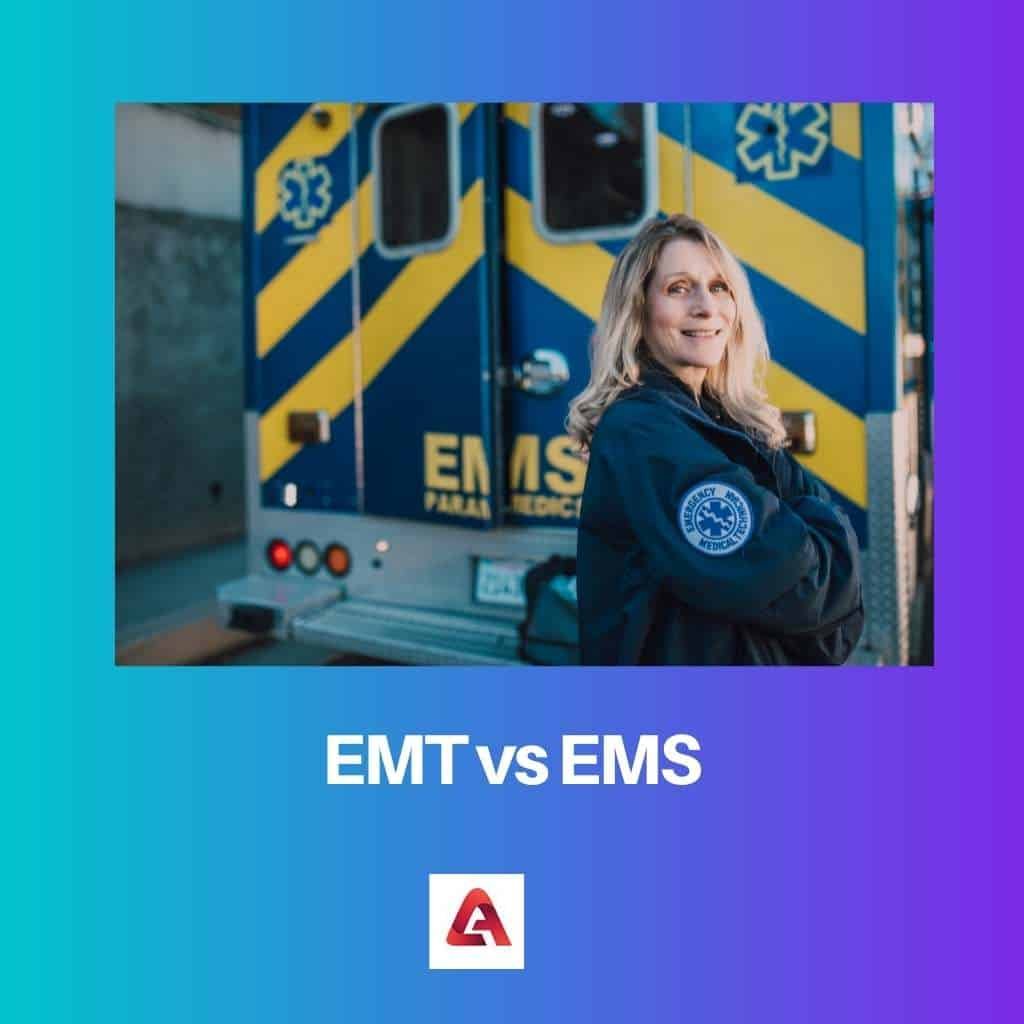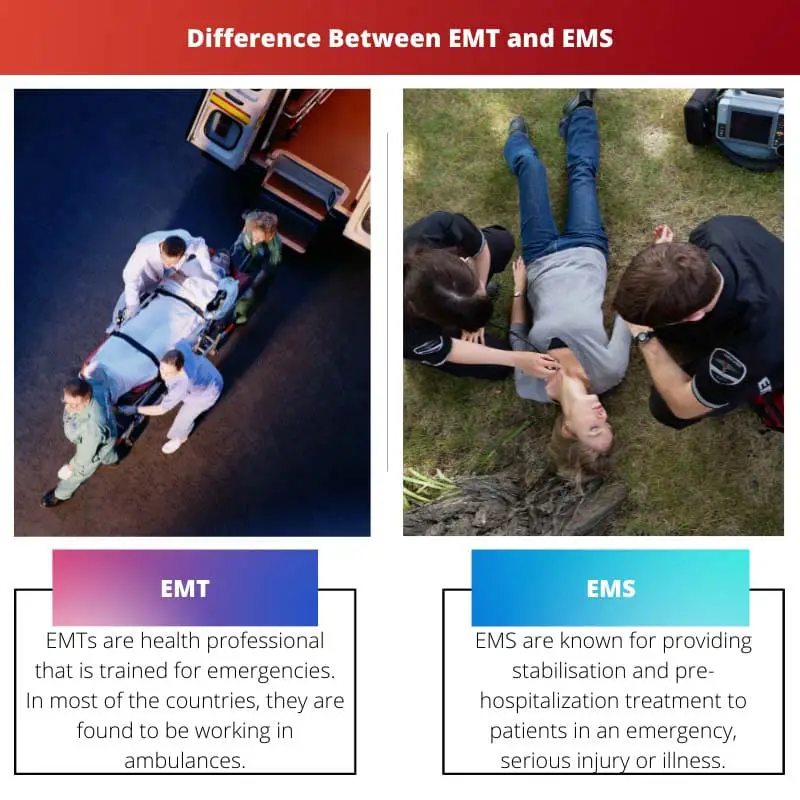The health sector is one of the important sectors that aggregate and integrates all the sectors within its systems, like goods and services, to treat patients with preventive, rehabilitative, curative, and palliative care. Modern healthcare includes the three main things that are important for the health economy, i.e., products, finance, and service.
The healthcare industry is one of the fastest-growing and the world’s largest industries. Health is one of the most important for all the economies around the globe and constitutes a major percentage of GDP.
EMTs and EMS are the health services related to paramedics or ambulances.
Key Takeaways
- EMTs provide basic life support, while EMS encompasses a broader range of medical services.
- EMTs are professionals within the EMS system, focusing on prehospital care.
- EMS involves various levels of responders, such as paramedics and emergency medical dispatchers.
EMT vs EMS
The difference between EMT and EMS is that EMT is a technician or professional. While EMS is the emergency service provided during the time of urgency or serious injury or illness of the patient. EMT is a part of the EMS. EMT means Emergency Medical Technician. While EMS means Emergency Medical Services.EMTs are professionals that are trained for emergencies. They are found to be working in ambulances. While EMS is the pre-hospitalization service, also called FAST Squad, Ambulance Squad, etc.

EMTs are health professional that is trained for emergencies. In most countries, they are found to be working in ambulances.
While in developed countries, there is a separate branch of paramedics. EMTs come under this branch, where they are additional requirements, education, qualification, and scope for it.
Commonly, EMTs are employed by municipal EMS agencies, governments, private ambulance services, hospitals, and fire departments. Some of the EMTs are paid, while other works voluntarily.
EMTs follow a protocol while treating the patient as recommended by the physician.
EMS, also called paramedic services, are known for providing stabilization and pre-hospitalization treatment to patients in an emergency, serious injury, or illness. Their work is to transport them to the care of the hospitals in ambulances.
EMS is called by various kinds of names, i.e., first aid squad, FAST squad, emergency squad, ambulance squad, ambulance corps, life squad, etc. EMS can be called by the public by the contact number provided to them at the emergency.
Then control facility will dispatch their units according to the situation.
Comparison Table
| Parameters of Comparison | EMT | EMS |
|---|---|---|
| Health coverage | Do not engage. | Wider coverage |
| Features | Only focus on basic life support. | Covers a range of life support. |
| Identification | Work in ambulances or private organizations. | Constitutes EMTs, & are owned by charities, police, fire ambulances, etc. |
| Purpose | Respond to emergency calls, and provide immediate care to the ill and injured. | Early detection, reporting, response, care, transfer, etc. |
| Levels | EMR, AEMT, Paramedics. | First aid, BLS, ILS, ALS, CCT. |
What is EMT?
EMTs are health professionals that had to do a lot of work, and they are exposed to various health hazards like treating infectious diseases, handling hazardous substances, lifting patients, equipment, and transportation via ground or air vehicles. Employers of the EMTs should provide them with a protective kit so that they can protect themselves as well as the patients.
Protective kits must include gloves, respirators, gowns, masks, etc. there are four different levels of EMTs in some of the countries like Canada and the United States.
They are Emergency Medical Responder, Primary care Paramedics, Advanced care Paramedics, and Critical care Paramedics. EMRs are the paramedics who work on the ground i.,e.
Responding to emergency calls and working on the ambulances. They are the first aid squad that is available to the public.
Primary care Paramedics are the basic type of medical care that are proficient in the treatment of emergencies, like providing epinephrine, dextrose, glucagon, salbutamol, oxygen, ASA, and nitroglycerine. Advanced care Paramedics are highly qualified professionals.
There demand in the health -sector is high. At times they perform 20 medications depending upon the region.
Critical care Provider works on the most critical and dangerous cases of patients. They work on transferring the patients to the hospitals where ACP are available.
They work in collaboration with nurses, ACP, PCP, therapists, etc. In different countries, there are various labels of care and practitioner. There is four major level of certification, i.e., EMR, EMT, AEMT, and Paramedics.
The training of the EMTs differs from course to course and country to country. EMTs require classroom training of 100-300 hours.
They are required to spend their time in ambulances and various types of hospital services like surgery, intensive care unit, obstetrics, emergency medicine, and psychiatry to complete the course and get certifications and licenses.

What is EMS?
EMS provides treatment to the public if it’s urgent on the scene. If it becomes very necessary, then the patients are transferred to the next hospital nearby.
EMS can be called one of the moving units of an emergency department. In developing countries, EMS means ambulances that transfer patients to hospitals.
But in the modern era and in most developed countries, this term became popular when EMS started diagnosing and treating patients on the spot. Training and qualification of the EMS differ in each region.
In some countries, members may be only qualified to drive ambulances with no medical training. In some places, members know the basic first aid facilities.
In European countries, members or personnel are trained in Advanced Life support and professional paramedics and EMTs. Physicians and nurses can be considered members of EMS in some countries depending upon their qualifications and training.
The first use of the EMS can be traced back to the time of the Napolean era when a vehicle was specifically designed for carrying the wounded. Then the advanced version of the ambulance carrier came in 1832 in England when EMS was required to carry patients with Cholera for treatment.
The first major ambulance service that the hospital provided came in the year 1865 at Commercial Hospital, Cincinnati, Ohio. Then it spread to New York and London.
The motorized version of the ambulance came in 1899 when businessmen donated it. Then the USA widely used ambulance services or EMS during World War 1&2 for carrying wounded soldiers.
In the 1960s more advanced version consisting of all the equipment for CPR and defibrillation was attached to it. Various organizations, like Government ambulance Services, Charity ambulance Services, Fire or police ambulance services, Private or combined emergency services, etc can provide EMS.
Main Differences Between EMT and EMS
- EMTs don’t involve or engage much in health awareness until they have been provided training and certifications. EMS is widely involved in health awareness, including life-threatening situations like fire, poisoning, transporting, etc.
- EMTs only focus on basic life support (BLS). EMS covers a wide range of life support, from first aid to advanced life support (ALS).
- EMTs work in ambulances or private organizations. EMS constitutes EMTs and can be owned by charities, police, fire departments, etc.
- The purpose of EMTs is to respond to emergency calls and provide efficient and immediate care to the critically ill and injured. EMS aims for Early detection, reporting, response, field care, transfer, etc.
- Levels of EMTs in certification include EMR, AEMT, and Paramedics. Levels of care in EMS include First aid, BLS, ILS, ALS, and CCT.




